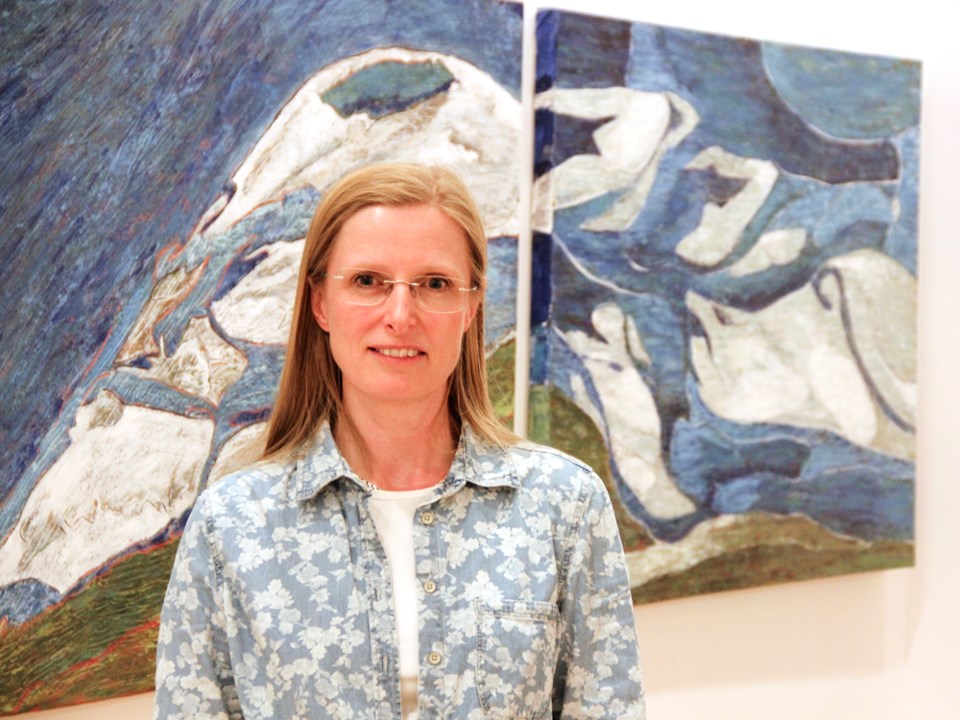Though there aren’t winners and losers in the art world, when it comes to an adjudicator decisions have to be made and a pair of selections have to be announced.
When it came time to announce the selections from this year’s Estevan Arts Council’s Adjudicated Art Show, two artists and their work stood out: Sharon Olson and Harvey Steeves.
Both submitted pieces wildly different from the other, yet they each created pieces that evoked memories, emotions and a desire for exploration. Olson’s pieces included five large paintings, abstract but still comprehensible as the aerial images of the South Saskatchewan River near Saskatoon that she took her inspiration from. Steeves’ selection of photographs display the mystery and wonder of the unknown with a deep look into what appears to be uninhabited forest.
The selections were made by adjudicator Ward Schell of Moose Jaw, who announced the pair of standouts at the Estevan Art Gallery and Museum where all of the art show submissions are available for viewing until Dec. 19.
Schell said artists are courageous not for displaying their work publicly but rather for the act of creating something from a place of personal experience and perspective. He said the submissions were excellent, and he isn’t always a fan of selecting winners when it comes to creative expression.
“There’s a better way to talk to people about their art,” he said, but added that the process is still important for artists because an adjudicator gives them a second pair of professional eyes to review a piece. “Art is about seeing, interpretation and vocalizing it through a medium.”
Turning to Olson’s work, Schell pointed to how well the pieces worked in a series of five paintings, calling the submissions “quite sophisticated.”
Olson, a school teacher in Caronport, said the images were inspired by aerial satellite images of the river she found on Google Earth. Her students call Google Earth Mrs. Olson’s magic school bus.
”I just find them very interesting and changeable. Everything is always changing in the river, so it’s my way of recording what was there,” said Olson. In that sense, the paintings play as snapshots of the past, documenting the shape of the land and flow of the river at a particular moment.
Though the paintings are inspired by those aerial images, the works themselves are abstract, with flowing blue strokes swirling around greens and whites.
“The interesting shapes that you see in Google Earth that you don’t necessarily see on the ground because of the perspective, I find very interesting.”
She said the shapes seen looking down at the Earth from above are all very organic and natural. There are no straight lines in nature. Pointing at the first piece she completed, Olson said it was the weird shapes of the landscape that struck her.
“I really enjoyed it and I thought I’d like to paint it.”
She didn’t paint it for a few years until she decided it was time to put brush to canvas.
After her first piece she did another two over the following summer, when she finds the time to paint. With more experience now, she returned to her first piece, which she decided could use more work.
“I reworked it quite a bit, adding more depth and texture to it,” she said.
With the art show submissions ranging widely in style, from painting and photography, to sculpture, fabric art and weaving, Schell noted he hasn’t dabbled in many of the media, but an artists’ sense of form, composition and colour remains the same.
“We speak the same language,” he said.
When it came to Steeves, who was not present for the announcement on Saturday, Schell said the conversation the two had about the work elevated it in Schell’s eyes, noting it isn’t standard-issue photography.
“The explanation and decision-making was checking off a lot of boxes of challenging creativity and the unknown,” said Schell, who added experimentation was “high risk.”
Steeves images include no post-production work, so all of the effects are made in the camera and required a lot of experimentation.
“They are haunting,” Schell said of the images, “but I want to go in there. I want to go in there and discover.”
The art show exhibit features Olson and Steeves’ works along with submissions from Emily Gillies, Diane Hume, Kayla Hanson, Cathy Wysman, Marleen Vicary, Sheila Farstad, Irene Roy, Cheryl Andrist and Kathryn Roberton.
To those artists, Schell invoked the words of one of his art professors at Emily Carr University of Art and Design, Bruce Boyd, who said artists aren’t normal.
A normal person who approaches a stop sign looks both ways and continues through the intersection, he told the students. An artist approaches the same corner and sees the shape and colour of the stop sign, the way the light strikes it and then looks both ways and continues through the intersection.



